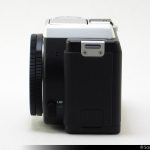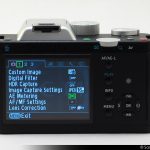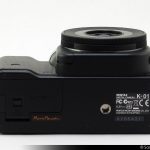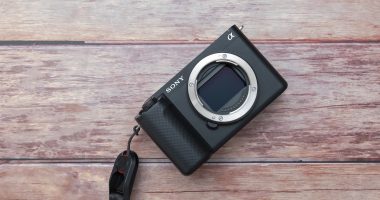 Here’s a camera that I honestly thought I would never get to see in person let along be able to use one. About a week ago, PENTAX sent me the Marc Newson designed K-01 hybrid camera to look at. If you haven’t heard about this camera, let me explain what it is. The K-01 is PENTAX’s second mirrorless system hybrid camera, their first being the PENTAX Q. The K-01 differs from the Q in which it is able to use much larger lenses, in fact, it uses regular PENTAX K-mount lenses. That means that if you already own any older PENTAX DSLR cameras, all the lenses from it would be compatible with the K-01.
Here’s a camera that I honestly thought I would never get to see in person let along be able to use one. About a week ago, PENTAX sent me the Marc Newson designed K-01 hybrid camera to look at. If you haven’t heard about this camera, let me explain what it is. The K-01 is PENTAX’s second mirrorless system hybrid camera, their first being the PENTAX Q. The K-01 differs from the Q in which it is able to use much larger lenses, in fact, it uses regular PENTAX K-mount lenses. That means that if you already own any older PENTAX DSLR cameras, all the lenses from it would be compatible with the K-01.
What sets the PENTAX K-01 apart from other mirrorless cameras isn’t the use of regular lenses however, even though that is a rather awesome feature. What sets it apart is its rather unique and sometimes controversial styling. The PENTAX K-01 has a way of drawing stares from anyone who sees it and has that love it or hate it kind of appeal to it. I’ll be honest and say that when I first saw the PENTAX K-01 when they first unveiled it, my reaction were rather negative towards its styling, especially when compared to cameras like the Sony NEX-5N and Olympus OM-D. To me, it looked very boxy, heavy, and toyish. Of course, this was all without me ever actually seeing or handling one in person. Seeing it in person though, my feelings about it have changed and I’ll explain why in my body & design analysis.
Body & Design
I’ll start this off by saying, if you’re looking for a small camera with hopes of replacing your bulky DSLR, this might not be the camera to get. It’s not really that much smaller than an entry level DSLR and any size reductions mainly come from the use of a slightly smaller grip and the omission of an optical viewfinder. Compared to my other mirrorless cameras that I own, the PENTAX K-01 has by far the largest body of them all. First a general observation about the PENTAX K-01 when taking it out of the box. The K-01 is not light. It is quite heavy and possible the heaviest mirrorless system camera I’ve had the pleasure of holding. The weight however makes the K-01 feel like a very solid and sturdy camera. I was also surprised to find that the camera is not as toyish as I first presumed. It might be because they sent me the black unit but having it here in person really changes your opinion about it.
 When you view the K-01 from the front, it kind of has an old-school retro look to it. It has a very rectangular shape to it when viewed directly head on. Most of the front surface is covered in a textured pinstripe rubber that continues along both sides. On the left side on the grip, you’ll find that there is an infrared sensor for a remote. I always find that this is a great option as it allows you to remotely set off the shutter from a distance, great for family photos. To the top right of the grip is the AF-assist light. Unlike most AF-assist lights that are red/orange in color, the K-01 features a green light. You’ll notice that the area around the lens protrudes quite a bit from the front surface and mainly one of the reasons why the camera is so large. Most other mirrorless cameras are much thinner here, the K-01 isn’t. I believe it has to be like this to accommodate those k-mount lenses. As you can see, most of the front is all black except for the on/off switch, mode select dial, and the flash hump that you can see from the front and are anodized matte silver.
When you view the K-01 from the front, it kind of has an old-school retro look to it. It has a very rectangular shape to it when viewed directly head on. Most of the front surface is covered in a textured pinstripe rubber that continues along both sides. On the left side on the grip, you’ll find that there is an infrared sensor for a remote. I always find that this is a great option as it allows you to remotely set off the shutter from a distance, great for family photos. To the top right of the grip is the AF-assist light. Unlike most AF-assist lights that are red/orange in color, the K-01 features a green light. You’ll notice that the area around the lens protrudes quite a bit from the front surface and mainly one of the reasons why the camera is so large. Most other mirrorless cameras are much thinner here, the K-01 isn’t. I believe it has to be like this to accommodate those k-mount lenses. As you can see, most of the front is all black except for the on/off switch, mode select dial, and the flash hump that you can see from the front and are anodized matte silver.
 Rotating the camera clockwise to the side, from here you can really see how thick the PENTAX K-01 really is. However, from this angle, if you pick up the K-01 with the 40mm lens, you’ll see just how incredibly thin this lens is. It is by far the thinnest prime lens I have ever seen and even has a manual focusing ring on it. It simply is amazing how small PENTAX made this. From this side, you’ll notice the rather large MF/AF switch which is a welcome site as it makes switching between the two very easy. On top, you’ll see a nice large strap eyelet that has a nice industrial look to it. Now, what you might not see here is the little rubber flap that is hidden quite nicely with the rubber decor that wraps around the camera. under this flap, you’ll find a mic port which you don’t normally see on mirrorless cameras. My NEX-5N doesn’t have one nor does my Olympus PEN E-PL3. As you can see, the K-01 has much in common with a more traditional DSLR.
Rotating the camera clockwise to the side, from here you can really see how thick the PENTAX K-01 really is. However, from this angle, if you pick up the K-01 with the 40mm lens, you’ll see just how incredibly thin this lens is. It is by far the thinnest prime lens I have ever seen and even has a manual focusing ring on it. It simply is amazing how small PENTAX made this. From this side, you’ll notice the rather large MF/AF switch which is a welcome site as it makes switching between the two very easy. On top, you’ll see a nice large strap eyelet that has a nice industrial look to it. Now, what you might not see here is the little rubber flap that is hidden quite nicely with the rubber decor that wraps around the camera. under this flap, you’ll find a mic port which you don’t normally see on mirrorless cameras. My NEX-5N doesn’t have one nor does my Olympus PEN E-PL3. As you can see, the K-01 has much in common with a more traditional DSLR.
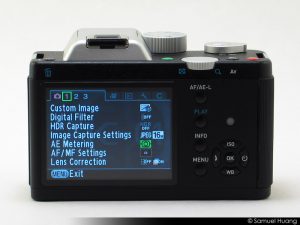 Looking at the back of the camera, the K-01 keeps things rather simple. Like with most digital cameras, the rear screen takes up most of the space. It’s a rather large 3.0″ diagonal screen. Not sure what the screen is made of but it seems pretty firm and in the time I’ve had it, I haven’t seen on scratch on it. Most of the rear is very flat and the screen sits flush with the body. There are the traditional 4 way directionalal buttons as well as the “OK” button centered in the middle of it. Where most cameras have more buttons position on the top and bottom of the directional buttons, PENTAX has them all lined up to the left of the directional buttons. At first it seems like a strange decision, but when using them, it’s actually quite a comfortable position to have them in and very easy for the thumb to reach. In line with these buttons up top you’ll find a nice control dial that is used to adjust various features on the camera depending on which mode or menu you’re in. I love when cameras come with some kind of adjustment dial on them. In my opinion it’s better then me having to press a button a bunch of times. Other than what I pointed out, the rear is very sparse and minimalistic, but this makes it very easy use.
Looking at the back of the camera, the K-01 keeps things rather simple. Like with most digital cameras, the rear screen takes up most of the space. It’s a rather large 3.0″ diagonal screen. Not sure what the screen is made of but it seems pretty firm and in the time I’ve had it, I haven’t seen on scratch on it. Most of the rear is very flat and the screen sits flush with the body. There are the traditional 4 way directionalal buttons as well as the “OK” button centered in the middle of it. Where most cameras have more buttons position on the top and bottom of the directional buttons, PENTAX has them all lined up to the left of the directional buttons. At first it seems like a strange decision, but when using them, it’s actually quite a comfortable position to have them in and very easy for the thumb to reach. In line with these buttons up top you’ll find a nice control dial that is used to adjust various features on the camera depending on which mode or menu you’re in. I love when cameras come with some kind of adjustment dial on them. In my opinion it’s better then me having to press a button a bunch of times. Other than what I pointed out, the rear is very sparse and minimalistic, but this makes it very easy use.
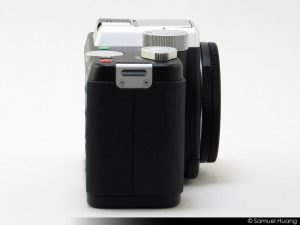 Rotating the camera clockwise again, we can get a view of the other side of the K-01. Again like the other side, it basically wrapped in the same rubber grip material that we see on the front. What’s interesting here is that you’d be hard pressed to tell that there was anything here at all except for the metal leash eyelit up top. In fact, there is a rubber hidden door here. On the left, if you lift up the grip, the door pops open which is made out of the same material as the grip. The door itself feel a bit flimsy and sometimes hard to close back up properly, but I do appreciate the stealthiness of it. Under the door, you’ll find another door, plastic this time, that covers up the opening for the SDHC card. You’ll also find an HDMI port and a combo PC/AV port. Again like I’ve stated in other reviews, I really like when the SDHC slot is located on the side instead of at the bottom because it allows for easy access to your memory card. When it’s placed at the bottom, sometimes it’s very difficult to get at if you have a tripod mount attached.
Rotating the camera clockwise again, we can get a view of the other side of the K-01. Again like the other side, it basically wrapped in the same rubber grip material that we see on the front. What’s interesting here is that you’d be hard pressed to tell that there was anything here at all except for the metal leash eyelit up top. In fact, there is a rubber hidden door here. On the left, if you lift up the grip, the door pops open which is made out of the same material as the grip. The door itself feel a bit flimsy and sometimes hard to close back up properly, but I do appreciate the stealthiness of it. Under the door, you’ll find another door, plastic this time, that covers up the opening for the SDHC card. You’ll also find an HDMI port and a combo PC/AV port. Again like I’ve stated in other reviews, I really like when the SDHC slot is located on the side instead of at the bottom because it allows for easy access to your memory card. When it’s placed at the bottom, sometimes it’s very difficult to get at if you have a tripod mount attached.
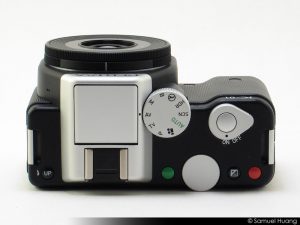 Time to take a look at the top of the camera. As you can see, the layout here is a bit different from what you might be used to and it looks like the designer here wanted to make use of a lot of the space on here. I’ll start with the on/off switch here which is made of aluminum and fairly large. At the center of it is the shutter release button. To the left of that you’ll find the mode select dial which is also made of aluminum. It has a very nice click to it and it’s in a position where it won’t accidentally switch modes when you don’t want it to. Below, you’ll see the other silver dial which is the adjustment dial I mentioned earlier. To the left and right of this, you’ll notice a green and red button. The green button is a programmable button that you can set for certain tasks. The red button is a dedicated movie record button. There’s also the EV button located just left of the red button. The huge aluminum block you see up top is where the popup flash is housed as well as the hotshoe for an external flash. Note though that this does not function with any sort of add on EVF as there isn’t one offered for the K-01. To the left of the flash you’ll also find the button for the flash release.
Time to take a look at the top of the camera. As you can see, the layout here is a bit different from what you might be used to and it looks like the designer here wanted to make use of a lot of the space on here. I’ll start with the on/off switch here which is made of aluminum and fairly large. At the center of it is the shutter release button. To the left of that you’ll find the mode select dial which is also made of aluminum. It has a very nice click to it and it’s in a position where it won’t accidentally switch modes when you don’t want it to. Below, you’ll see the other silver dial which is the adjustment dial I mentioned earlier. To the left and right of this, you’ll notice a green and red button. The green button is a programmable button that you can set for certain tasks. The red button is a dedicated movie record button. There’s also the EV button located just left of the red button. The huge aluminum block you see up top is where the popup flash is housed as well as the hotshoe for an external flash. Note though that this does not function with any sort of add on EVF as there isn’t one offered for the K-01. To the left of the flash you’ll also find the button for the flash release.
 Let’s take a look at the bottom of the K-01 now. Here, you can see that for the most part, there really isn’t much of anything down here. From here though, you can really see the bulkiness of the K-01 and just how rectangular and “brick” like it is. The batter door is located on the very far left where you’ll also notice the designer’s name. Strange place for it considering this is a big selling point of the camera and would have made more sense if it were on the front or rear of the camera. I’m glad that PENTAX saw fit here to place the tripod mount hole directly center of the lens axis. This is a much better position for those who use tripods a lot. Other than the door and the tripod hole, there’s nothing else really of interest on the bottom of the camera.
Let’s take a look at the bottom of the K-01 now. Here, you can see that for the most part, there really isn’t much of anything down here. From here though, you can really see the bulkiness of the K-01 and just how rectangular and “brick” like it is. The batter door is located on the very far left where you’ll also notice the designer’s name. Strange place for it considering this is a big selling point of the camera and would have made more sense if it were on the front or rear of the camera. I’m glad that PENTAX saw fit here to place the tripod mount hole directly center of the lens axis. This is a much better position for those who use tripods a lot. Other than the door and the tripod hole, there’s nothing else really of interest on the bottom of the camera.
Final Thoughts
 The PENTAX K-01 does seem like a very bulky camera and it definitely is much larger than the other mirrorless system cameras I’ve seen in the past. In fact, like I stated above, it really isn’t that much smaller than a DSLR. But you know what? I like it. Having it here in front of me, my feelings about it have changed. It has an appeal to it that not everyone is going to like. It’s large, boxy, and heavy. But you know what it also is? It’s attention grabbing, different, and very functional and minimalistic.
The PENTAX K-01 does seem like a very bulky camera and it definitely is much larger than the other mirrorless system cameras I’ve seen in the past. In fact, like I stated above, it really isn’t that much smaller than a DSLR. But you know what? I like it. Having it here in front of me, my feelings about it have changed. It has an appeal to it that not everyone is going to like. It’s large, boxy, and heavy. But you know what it also is? It’s attention grabbing, different, and very functional and minimalistic.
Holding it in my hands, it’s actually more comfortable than it looks and the large size means those with larger hands will have no problem using it. I also really like the fact that because of the way PENTAX designed this hybrid camera to accommodate their already existing lineup of K-mount lenses, it means that there would be no need for current PENTAX DSLR owners to buy new lenses. That also means that PENTAX has the largest assortment of lenses available for any mirrorless camera today and all the lenses are 100& compatible. That’s the one problem I have with my Sony NEX-5N. There are not that many E-mount lenses to choose from so I have to use an adaptor in order to use lenses from other manufacturers. That means I also lose most automatic functions in the lens. PENTAX made it easy to go from DSLR to mirrorless camera and back without any fancy adapters.
I’ve had a chance to shoot some photos with the K-01 already, but I’ll post up sample images and a full review later. All I can say is that the K-01 does a fantastic job of taking photos with excellent image quality and overall ease of use.
Shop Links
- PENTAX K-01 Black (Body Only) – Pentax K-01 Body (Black)
- PENTAX K-01 Yellow (Body Only) – Pentax K-01 Body (Yellow)
- PENTAX K-01 White (Body Only) – Pentax K-01 Body (White)
- PENTAX K-01 Black (w/40mm Lens) – Pentax K-01 Kit with DA 40mm Lens (Black)
- PENTAX K-01 Yellow (w/40mm Lens) – Pentax K-01 Kit with DA 40mm Lens (Yellow)
- PENTAX K-01 White (w/40mm Lens) – Pentax K-01 Kit with DA 40mm Lens (White)






